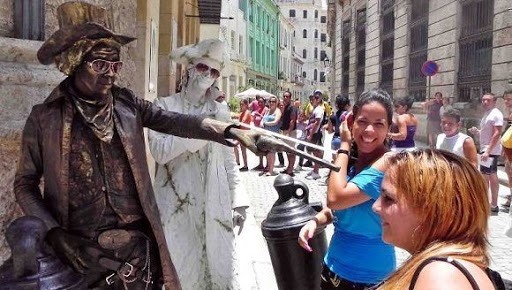
LAS ESTATUAS VIVIENTES de la Habana, Capital de la Isla de Cuba. PHOTOS.
Una de las más atractivas funciones que se desarrollan en las distintas plazas y calles del Centro Histórico de la Ciudad, resultan ser los artistas que hacen el papel de estatuas vivientes, los cuales pertenecen al denominado Grupo de Giganterías.
Así hay estatuas humanas de personajes cubanos y de otras latitudes, de épocas anteriores a la presente que impresionan tanto por las características físicas como por el vestuario. Por ejemplo El Caballero de París, está excelentemente representado con un parecido físico increíble y una indumentaria exacta a la estatua de bronce colocada en la entrada principal de la Sala de Conciertos de la Basílica Menor de San Francisco de Asís.
También puede apreciarse la caracterización de El Arlequín, bellamente engalanado con traje, sombrero con largos cuernos y botas, todo de color amarillo. Otra de esas estatuas vivientes ha sido la de El Restaurador. Con su vestuario plateado, el artista parece estar petrificado sosteniendo una larga soga enrollada, tijeras, casco, cubo y martillo.
También en La Habana Vieja se aprecia el Hombre de Barro, con un larguísimo sobretodo, guantes, sombrero en forma de cono y botas, recubiertas de un color carmelita claro. En la esquina donde confluyen las calles de Los Mercaderes y Amargura, se mantiene estático el Cowboy, que responde al nombre de Macho Rico, con un sobretodo, sombrero de copa, una cadena de oro encima del chaleco y pistola en mano.
Cuando algunos de los que los aprecian, le ofrecen a manera de regalo alguna moneda estas estatuas vivientes abandonan por segundos su estatismo y agradecen con ligeros movimientos, sonrisas y alguna expresión oral en determinado casos.Particular emoción causa esto en los niños que de pronto descubren que esa aparente estatua es sencillamente un ser humano.
MOVIMIENTO TEATRAL DE CUBA
Cuba posee un gran movimiento teatral que se dedica a fomentarla y se disemina por los centros históricos de La Habana, Santiago de Cuba, Matanzas, Cienfuegos o Trinidad, entre otras.
Particularmente en La Habana Vieja, Patrimonio de la Humanidad desde 1982, constituyen todo un espectáculo teatral.
Comenzó a desarrollarse este arte, a partir de los años 2000, pero sobre todo en obras teatrales cerradas.
En 2005, gracias al grupo teatral Gigantería y a la Oficina del Historiador de La Habana, se expandió por la ciudad y por el resto del país.
En la actualidad, realizan actividades no solo en las calles, sino también en escuelas y hospitales, sobre todo para los niños y jóvenes.
Los jóvenes artistas, devenidos magos del disfraz y la paciencia, dedican parte del día a la preparación de su atuendo y maquillaje, para poder permanecer inertes durante horas al sol, ante la mirada de asombrada de transeúntes cubanos y extranjeras.
Estos hombres y mujeres logran seducir a partir de los gestos lentos de su propio cuerpo, y en su piel ponen diversos materiales, con maquillajes y pinturas acrílicas con colores: el oro, la plata, la roca e, incluso, la madera. Al disfraz, le añaden artículos propios para su interpretación.
Nace, desde la inmovilidad inadvertida, un museo viviente a la intemperie, donde escenifican a personalidades excelsas de la cultura cubana. No escapa la interpretación de estrafalarios personajes, que pueden ir desde un cansado campesino hasta un pirata amenazante.
Entre otros personajes encarnados, figuran La Giraldilla, símbolo de La Habana desde hace siglos; el caricaturesco Charles Chaplin; el flautista de Hamelín, de las legendarias fábulas de los Hermanos Grimm, por citar algunos.
En la actualidad, muchos trabajan de manera independiente, con el apoyo de la Oficina del Historiador de la Ciudad de La Habana. Algunos ya tienen sus personajes creados y sus espacios de exhibición, pero constantemente buscan renovarse y crear nuevos personajes.
Mirémoslos como seres fantásticos que parecen acomodarse tranquilamente a la urbe de cinco siglos de fundada, una de las Ciudades mas sucias y abandonadas del Mundo Moderno.
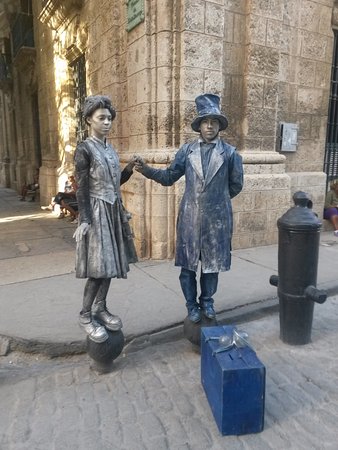
THE LIVING STATUES OF HAVANA, CAPITAL OF THE ISLAND OF CUBA. PHOTOS.
One of the most attractive performances that take place in the different squares and streets of the Historic Center of the City, are the artists who play the role of living statues, which belong to the so-called Group of Giganterías.
Thus there are human statues of Cuban characters and of other latitudes, from times before the present that impress as much for the physical characteristics as for the costumes. For example, The Knight of Paris, is excellently represented with an incredible physical resemblance and exact clothing to the bronze statue placed at the main entrance of the Concert Hall of the Minor Basilica of San Francisco de Asís.
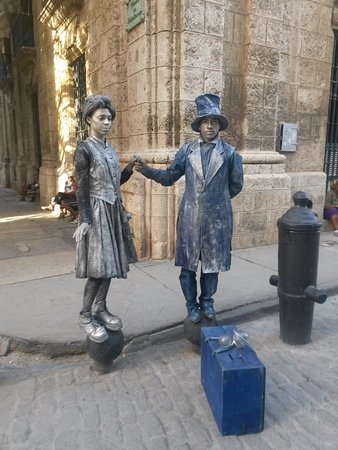
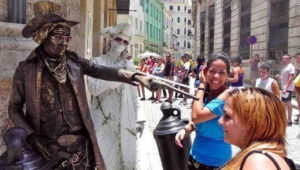
You can also appreciate the characterization of The Harlequin, beautifully adorned with a suit, hat with long horns and boots, all in yellow. Another of these living statues has been that of The Restorer. With his silver costume, the artist seems to be petrified, holding a long coiled rope, scissors, a helmet, a bucket and a hammer.
Also in Old Havana, the Clay Man can be seen, with a very long overcoat, gloves, a cone-shaped hat and boots, covered in a light brown colour. On the corner where the streets of Los Mercaderes and Amargura meet, the Cowboy, who answers to the name of Macho Rico, remains static, with an overcoat, a top hat, a gold chain over his vest and a gun in his hand.
When some of those who appreciate them offer them a coin as a gift, these living statues abandon their stillness for a few seconds and thank them with slight movements, smiles and some oral expression in certain cases. This causes particular emotion in children who suddenly discover that this apparent statue is simply a human being.
CUBAN THEATRICAL MOVEMENT
This art began to develop in the 2000s, but especially in closed plays.
In 2005, thanks to the Gigantería theater group and the Office of the Historian of Havana, it expanded throughout the city and the rest of the country.
Currently, they carry out activities not only in the streets but also in schools and hospitals, especially for children and young people.
The young artists, become magicians of disguise and patience, dedicate part of the day to preparing their clothes and makeup, to be able to remain inert for hours in the sun, before the astonished gaze of Cuban and foreign passers-by.
These men and women manage to seduce from the slow gestures of their own bodies, and on their skin, they put various materials, with makeup and acrylic paints with colors: gold, silver, rock, and even wood. To the costume, they add their own articles for their interpretation.
A living museum in the open is born, from inadvertent immobility, where exalted personalities of Cuban culture are staged. The interpretation of quirky characters does not escape, which can range from a tired peasant to a menacing pirate.
Among other characters incarnated are La Giraldilla, a symbol of Havana for centuries; the cartoonish Charles Chaplin; the Pied Piper of Hamelin, from the legendary Fables of the Brothers Grimm, to name a few.
Today, many work independently, with the support of the Office of the Historian of the City of Havana. Some already have their characters created and their exhibition spaces, but they constantly seek to renew themselves and create new characters.
Let’s look at them as fantastic beings who seem to calmly settle into the five-century-old city, one of the dirtiest and most abandoned cities in the Modern World.
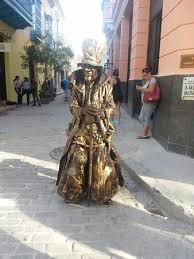
Agencies/ Wiki/ EstatuasVivientesHist./ RHC/ Guadalupe Yaujar/ Maite González/ Internet Photos/ Arnoldo Varona/ www.TheCubanHistory.com
THE CUBAN HISTORY, HOLLYWOOD.
LA HISTORIA DE CUBA.




 LAS ESTATUAS VIVIENTES DE LA HABANA, Capital de la Isla de Cuba. PHOTOS. * THE LIVING STATUES OF HAVANA, Capital of the Island of Cuba. PHOTOS.
LAS ESTATUAS VIVIENTES DE LA HABANA, Capital de la Isla de Cuba. PHOTOS. * THE LIVING STATUES OF HAVANA, Capital of the Island of Cuba. PHOTOS.